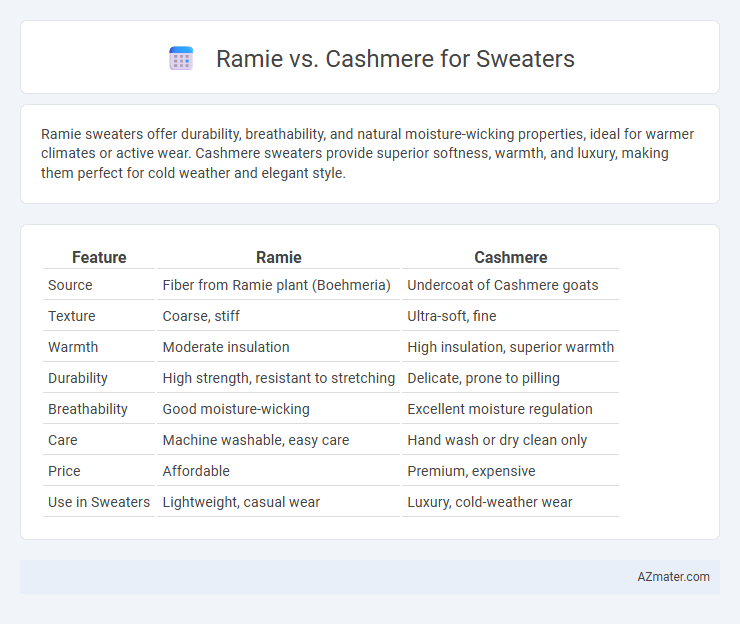Ramie sweaters offer durability, breathability, and natural moisture-wicking properties, ideal for warmer climates or active wear. Cashmere sweaters provide superior softness, warmth, and luxury, making them perfect for cold weather and elegant style.
Table of Comparison
| Feature | Ramie | Cashmere |
|---|---|---|
| Source | Fiber from Ramie plant (Boehmeria) | Undercoat of Cashmere goats |
| Texture | Coarse, stiff | Ultra-soft, fine |
| Warmth | Moderate insulation | High insulation, superior warmth |
| Durability | High strength, resistant to stretching | Delicate, prone to pilling |
| Breathability | Good moisture-wicking | Excellent moisture regulation |
| Care | Machine washable, easy care | Hand wash or dry clean only |
| Price | Affordable | Premium, expensive |
| Use in Sweaters | Lightweight, casual wear | Luxury, cold-weather wear |
Introduction to Ramie and Cashmere
Ramie is a natural fiber derived from the stalks of the Chinese nettle plant, known for its durability, breathability, and silky texture, making it a sustainable alternative for lightweight sweaters. Cashmere, sourced from the undercoat of cashmere goats, is prized for its exceptional softness, warmth, and luxurious feel, often used in high-end knitwear. Both fibers offer unique benefits for sweaters, with ramie excelling in strength and moisture-wicking properties and cashmere providing unparalleled insulation and comfort.
Origins and History of Ramie and Cashmere
Ramie, one of the oldest natural fibers, originates from the stalks of the Boehmeria plant, cultivated primarily in China and Southeast Asia for over 6,000 years. Cashmere is derived from the undercoat of Cashmere goats native to the mountainous regions of Kashmir, Mongolia, and Nepal, prized since the 3rd century BC for its exceptional softness and insulation. Both fibers have rich histories tied to ancient textile traditions, with ramie known for its durability and sheen, while cashmere highlights luxury and warmth in sweater production.
Fiber Characteristics: Ramie vs Cashmere
Ramie fiber, derived from the stalks of the Boehmeria plant, is known for its strength, durability, and moisture-wicking properties, offering a crisp texture ideal for lightweight sweaters. Cashmere, sourced from the undercoat of Cashmere goats, provides exceptional softness, warmth, and a luxurious, fine fiber structure that enhances comfort and insulation. While ramie excels in breathability and resilience, cashmere is prized for its superior thermal regulation and plush feel, making each suitable for different sweater needs.
Texture and Comfort Comparison
Ramie fibers create a sturdy, slightly coarse texture that becomes softer with wear, offering a breathable and durable option for sweaters. Cashmere provides an exceptionally soft, luxurious feel with fine, lightweight fibers that excel in warmth and comfort against the skin. While cashmere delivers superior softness and insulation, ramie sweaters are favored for their strength and moisture-wicking properties, making the choice dependent on desired texture and comfort level.
Durability and Longevity
Ramie fibers, derived from the nettle family plant, offer high durability and resistance to wear, making sweaters long-lasting even with frequent use. Cashmere, sourced from the undercoat of cashmere goats, provides exceptional softness but requires more delicate care to maintain its longevity and prevent pilling. For durability and extended lifespan, ramie sweaters outperform cashmere, especially in environments demanding robust fabric resilience.
Warmth and Insulation Properties
Ramie sweaters offer moderate warmth due to their natural fiber structure but lack the superior insulation properties found in cashmere. Cashmere provides exceptional thermal insulation by trapping air within its fine, soft fibers, making it ideal for retaining body heat in cold conditions. The lightweight nature of cashmere combined with its superior warmth makes it a preferred choice over ramie for insulating sweaters.
Care and Maintenance Requirements
Ramie sweaters require gentle hand washing in cold water and air drying to maintain fiber strength and prevent shrinking, while cashmere demands more delicate care with mild detergent, careful hand washing, and laying flat to dry to avoid pilling and deformation. Both fabrics benefit from storage in breathable garment bags and occasional use of a cashmere comb or fabric brush to preserve their softness and appearance. Proper maintenance extends the lifespan of ramie and cashmere sweaters, ensuring they retain their natural luster and comfort.
Sustainability and Environmental Impact
Ramie fiber, derived from the nettle plant, offers a highly sustainable option for sweaters due to its fast growth and minimal need for pesticides or fertilizers, reducing environmental impact compared to conventional crops. Cashmere production often involves intensive grazing by goats, leading to land degradation, desertification, and significant ecological strain, making it less sustainable in comparison. Choosing ramie over cashmere supports lower water consumption and a smaller carbon footprint, aligning with eco-friendly fashion practices and promoting responsible textile sourcing.
Price and Accessibility
Ramie sweaters are generally more affordable and widely accessible compared to cashmere, making them a cost-effective choice for budget-conscious shoppers. Cashmere fibers are rare and labor-intensive to harvest, which significantly increases the price and limits availability in mainstream markets. Ramie's strong, durable fibers are cultivated from plants, offering a sustainable yet economical alternative to luxurious cashmere.
Which Is Best for Your Sweater: Ramie or Cashmere?
Cashmere offers unparalleled softness and warmth, making it ideal for luxurious sweaters with a cozy, lightweight feel. Ramie provides exceptional durability, breathability, and moisture-wicking properties, perfect for sweaters suited to warmer climates or active wear. Choosing between ramie and cashmere depends on whether you prioritize softness and insulation or strength and breathability for your sweater.

Infographic: Ramie vs Cashmere for Sweater
 azmater.com
azmater.com